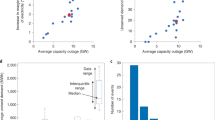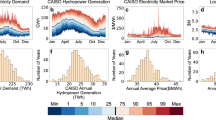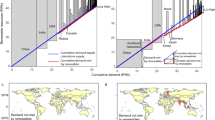Abstract
Climate change may constrain future electricity generation capacity by increasing the incidence of extreme heat and drought events. We estimate reductions to generating capacity in the Western United States based on long-term changes in streamflow, air temperature, water temperature, humidity and air density. We simulate these key parameters over the next half-century by joining downscaled climate forcings with a hydrologic modelling system. For vulnerable power stations (46% of existing capacity), climate change may reduce average summertime generating capacity by 1.1–3.0%, with reductions of up to 7.2–8.8% under a ten-year drought. At present, power providers do not account for climate impacts in their development plans, meaning that they could be overestimating their ability to meet future electricity needs.
This is a preview of subscription content, access via your institution
Access options
Subscribe to this journal
Receive 12 print issues and online access
$209.00 per year
only $17.42 per issue
Buy this article
- Purchase on Springer Link
- Instant access to full article PDF
Prices may be subject to local taxes which are calculated during checkout



Similar content being viewed by others
References
Van Vliet, M. T. H. et al. Vulnerability of US and European electricity supply to climate change. Nature Clim. Change 2, 676–681 (2012).
Harto, C. B. & Yan, Y. E. Analysis of Drought Impacts on Electricity Production in the Western and Texas Interconnections of the United States (Environmental Science Division, Argonne National Laboratory, 2011).
Kimmell, T. A. & Veil, J. A. Impact of Drought on US Steam Electric Power Plant Cooling Water Intakes and Related Water Resource Management Issues Report No. DOE/NETL-2009/1364 (National Energy Technology Laboratory, 2009).
Sathaye, J. et al. Estimating Risk to California Energy Infrastructure from Projected Climate Change (California Energy Commission, 2012).
Rutberg, M. J. Modeling Water Use at Thermoelectric Power Plants MS thesis, Massachusetts Inst. Technology (2003).
Dubey, S., Sarvaiya, J. N. & Seshadri, B. Temperature dependent photovoltaic (PV) efficiency and its effect on PV production in the world—a review. Energy Procedia 33, 311–321 (2013).
Wind Turbine Power Calculations (Royal Academy of Engineering, 2014); https://www.raeng.org.uk/education/diploma/maths/pdf/exemplars_advanced/23_Wind_Turbine.pdf
Rising Temperatures Undermine Nuclear Power’s Promise (Union of Concerned Scientists Backgrounder, 2007).
Guide to Tools and Principles for a Dry Year Strategy (Bonneville Power Administration, 2002); http://www.bpa.gov/power/pgp/dryyear/08-2002_Draft_Guide.pdf
Operating Experience with Nuclear Power Stations in Member States in 2003 (International Atomic Energy Agency, 2004)
IPCC Climate Change 2007: Impacts, Adaptation and Vulnerability (eds Parry, M. L.et al.) (Cambridge Univ. Press, 2008).
Koch, H. & Vögele, S. Dynamic modelling of water demand, water availability, and adaptation strategies for power plants to global change. Ecol. Econ. 68, 2031–2039 (2009).
Form EIA-860 Detailed Data (US Energy Information Administration, 2012); www.eia.gov/electricity/data/eia860
Electric Power Projections by Electricity Market Module Region Tables 55.19-22 (Annual Energy Outlook 2014 Data Tables, US Energy Information Administration, 2014); http://www.eia.gov/forecasts/archive/aeo14/data.cfm
NERC Reliability FAC-010-1, FAC-011-1: Determine Facility Ratings, System Operating Limit and Transfer Capabilities (Western Electricity Coordinating Council, 2006); http://www.nerc.com/pa/Stand/Determine%20Facility%20Ratings%20Operating%20Limits%20and%20Tr/WECC_Support_for_Reg_Diff_revised_05Sep06.pdf
Learn More About Interconnections (US Department of Energy, 2015); http://energy.gov/oe/services/electricity-policy-coordination-and-implementation/transmission-planning/recovery-act-0
Liang, X., Lettenmaier, D. P., Wood, E. F. & Burges, S. J. A simple hydrologically based model of land-surface water and energy fluxes for general-circulation models. J. Geophys. Res. 99, 14415–14428 (1994).
Lohmann, D., Raschke, E., Nijssen, B. & Lettenmaier, D. P. Regional scale hydrology: I. Formulation of the VIC-2L model coupled to a routing model. Hydrol. Sci. J. 43, 131–141 (1998).
Yearsley, J. R. A semi-Lagrangian water temperature model for advection-dominated river systems. Water Resour. Res. 45, W12405 (2009).
Maurer, E. P., Wood, A. W., Adam, J. C., Lettenmaier, D. P. & Nijssen, B. A long-term hydrologically-based data set of land surface fluxes and states for the conterminous United States. J. Clim. 15, 3237–3251 (2002).
Downscaled CMIP3 and CMIP5 Climate and Hydrology Projections: Release of Downscaled CMIP5 Climate Projections, Comparison with preceding Information, and Summary of User Needs (US Department of the Interior, Bureau of Reclamation, Technical Services Center, 2013)
2013 Long-Term Reliability Assessment (North American Electric Reliability Corporation, 2013); http://www.nerc.com/pa/RAPA/ra/Reliability%20Assessments%20DL/2013_LTRA_FINAL.pdf
Acknowledgements
This material is based on work supported by the National Science Foundation (grant numbers IMEE 1335556, IMEE 1335640, WSC 1360509, RIPS 1441352 and BCS 102686).
Author information
Authors and Affiliations
Contributions
M.D.B. and M.V.C. designed the study. M.D.B. performed all analyses and collaborated with M.V.C. in interpreting the results and drafting the manuscript.
Corresponding author
Ethics declarations
Competing interests
The authors declare no competing financial interests.
Supplementary information
Rights and permissions
About this article
Cite this article
Bartos, M., Chester, M. Impacts of climate change on electric power supply in the Western United States. Nature Clim Change 5, 748–752 (2015). https://doi.org/10.1038/nclimate2648
Received:
Accepted:
Published:
Issue Date:
DOI: https://doi.org/10.1038/nclimate2648
This article is cited by
-
Reliance on fossil fuels increases during extreme temperature events in the continental United States
Communications Earth & Environment (2023)
-
Climate change adaptation mechanisms and strategies of coal-fired power plants
Mitigation and Adaptation Strategies for Global Change (2022)
-
The impact of weather changes on the supply and demand of electric power and wholesale prices of electricity in Germany
Sustainability Science (2022)
-
Using Fractional Order Grey Seasonal Model to Predict the Power Generation in China
Environmental Processes (2021)
-
The critical role of humidity in modeling summer electricity demand across the United States
Nature Communications (2020)



